CONTENTS
- The conflict behind eco-sensitive zones
- National Green Tribunal
- Annual Status of Education Report
- China’s population falls
The Conflict Behind Eco-Sensitive Zones
Context:
Ecologically sensitive zones (ESZ) are intended to safeguard ‘protected areas’ — national parks and wildlife sanctuaries — by transitioning from an area of lower protection to an area of higher protection. However, the creation of these zones has provoked protests in Kerala and some other regions, in a precursor to what is likely to emerge in other parts of the country.
Relevance:
GS III: Environment and Ecology
Dimensions of the Article:
- What are protected areas?
- Implementation of Forest Rights Act (FRA)
- Eco-Sensitive Zones (ESZs)
- Problem with ESZs in Scheduled Areas
- What has led to the protests?
What are protected areas?
- Protected areas cover 5.26% of India’s land area as 108 national parks and 564 wildlife sanctuaries. They are notified under the Wildlife (Protection) Act 1972.
- Protected areas do away with even those activities permitted in ‘reserve forests’, where the rights of forest-dependent communities — those residing on and/or accessing forest land — are extinguished, unless specifically allowed.
- However, this rights-negating ‘fortress conservation model’, has come under repeated criticism from conservation scientists, bringing in the Scheduled Tribes and Other Traditional Forest Dwellers (Recognition of Forest Rights) Act 2006 which is also known as the Forest Rights Act (FRA).
- FRA recognises the customary and traditional rights (both individual and collective) of forest-dwellers on forest land, including in protected areas.
Implementation of Forest Rights Act (FRA)
Overview of FRA implementation
- FRA was enacted to undo historic injustice done to the forest dwelling community of India.
- The Ministry of Environment, Forests and Climate Change (MoEFCC) estimated that it would mean handing over at least 4 lakh sq. km of India’s notified forest area to village-level institutions.
- As of June 2022, only 64,873.70 sq. km, or 16%, has come under the FRA.
- This has been achieved in a decade and a half, compared to no improvements in the six decades before.
Role of Gram Sabhas
- Gram Sabhas have taken over the power to determine rights through open democratic process from government officials.
- They are now the statutory authorities empowered to conserve, protect and manage forests, wildlife and biodiversity lying within traditional village boundaries.
- These areas under gram sabhas are to be a new category of forests called ‘community forest resource’ (CFR).
- Gram sabhas have to integrate their CFR conservation and management plan into the ‘working plan’ of the Forest Department, with the required modifications.
Eco-Sensitive Zones (ESZs)
- Eco Sensitive Zones are fragile areas around protected areas declared by the Ministry of Environment, Forest, and Climate Change (MoEFCC).
- They are areas notified by the MoEFCC around Protected Areas, National Parks and Wildlife Sanctuaries. • The purpose of declaring ESZs is to create some kind of “shock absorbers” to the protected areas by regulating and managing the activities around such areas.
- Among activities prohibited in the eco-sensitive zone are hydroelectric projects, brick kilns, commercial use of firewood and discharge of untreated effluents in natural water bodies or land areas.
- No new commercial hotels and resorts shall be permitted within 1 km of the boundary of the protected area or up to the extent of the eco-sensitive zone, whichever is nearer, except for small temporary structures for eco-tourism activities.
Overview of ESZs in India
- Surrounding protected areas is a region of more than 1,11,000 sq. km — or 3.4% percent of the country’s land — which falls under the ESZ regime.
- Governments have notified 341 ESZs in 29 States and five Union territories, while another 85 ESZs are awaiting notification.
- Together, protected areas and ESZs cover 8.66% of India’s land area.
- The ESZs span notified forests outside protected areas, most of which could also come under gram sabhas’ jurisdiction under the FRA.
- The extent of ESZs from the boundary of a protected area ranges from 0 to as much as 45.82 km (in Pin Valley National Park, Himachal Pradesh). Fifteen States have ESZs exceeding 10 km.
Problem with ESZs in Scheduled Areas
- Significantly, parts of the ESZs in ten States — Andhra Pradesh, Chhattisgarh, Gujarat, Himachal Pradesh, Jharkhand, Madhya Pradesh, Maharashtra, Odisha, Rajasthan and Telangana — fall within the Scheduled Areas notified under the Fifth Schedule of the Constitution.
- Such Scheduled Areas cover over 11% of the country’s land area and are thickly forested and mountainous.
- They are preponderantly populated by Scheduled Tribe groups and are notified by the President under Article 244 where the Provisions of the Panchayat (Extension to Scheduled Areas) Act (PESA) 1996 apply.
- The PESA recognises habitation-level gram sabhas to be competent to safeguard and preserve community resources on forest and revenue lands in Scheduled Areas.
- However, the MoEFCC has shown no inclination to amend the Indian Forest Act 1927, the Wildlife (Protection) Act, 1972 and the Environment (Protection) Act 1986 (under which ESZs are notified) to comply with the PESA and FRA.
What has led to the protests?
Supreme Court’s Directions on Eco-Sensitive Zones (ESZs)
- The Court stated that MoEFCC guidelines must be implemented in areas proposed in draft notifications and within a 10 km radius of yet-to-be-proposed protected areas.
- States were given the authority to increase or decrease the minimum width of ESZs.
- Powers were given to the Principal Chief Conservator of Forests (PCCF) and Home Secretary of the State/UT to ensure compliance with guidelines.
- PCCF was to make a list of all structures within the ESZs and report it to the Supreme Court within three months.
- Court ordered that no new permanent structure could come up for any purpose within an ESZ.
Impact of the Court’s Directions
- All activities permitted by guidelines can only continue if PCCF grants permission, within 6 months of court’s order.
- This period has already expired and has led to protests in Kerala.
- Banned structures include electric poles, buildings, walls, roads, and bridges.
- Millions of forest-dwellers living on forest land and on the fringes of forests are most affected.
- After being denied forest rights, they are now also denied better public infrastructure.
- The government and the judiciary need to reconcile laws, reaffirm democratic governance, and protect the environment.
-Source: The Hindu
National Green Tribunal
Context:
The National Green Tribunal (NGT) has set a four-month deadline for remedial actions and recovering damages from the Kulda coal mine run by Mahanadi Coalfields Limited (MCL) in Odisha and the Tamnar thermal plant operated by Jindal Power Limited (JPL) in Chhattisgarh for transporting coal through villages in violation of environmental clearance (EC) conditions.
Relevance:
GS-III: Environment and Ecology
Dimensions of the Article:
- National Green Tribunal (NGT)
- Structure of National Green Tribunal
- Powers of NGT
- Challenges related to the NGT
- About Corbett National Park:
National Green Tribunal (NGT)
- The NGT was established on October 18, 2010 under the National Green Tribunal Act 2010, passed by the Central Government.
- National Green Tribunal Act, 2010 is an Act of the Parliament of India which enables creation of a special tribunal to handle the expeditious disposal of the cases pertaining to environmental issues.
- NGT Act draws inspiration from the India’s constitutional provision of (Constitution of India/Part III) Article 21 Protection of life and personal liberty, which assures the citizens of India the right to a healthy environment.
- The stated objective of the Central Government was to provide a specialized forum for effective and speedy disposal of cases pertaining to environment protection, conservation of forests and for seeking compensation for damages caused to people or property due to violation of environmental laws or conditions specified while granting permissions.
Structure of National Green Tribunal
- Following the enactment of the said law, the Principal Bench of the NGT has been established in the National Capital – New Delhi, with regional benches in Pune (Western Zone Bench), Bhopal (Central Zone Bench), Chennai (Southern Bench) and Kolkata (Eastern Bench). Each Bench has a specified geographical jurisdiction covering several States in a region.
- The Chairperson of the NGT is a retired Judge of the Supreme Court, Head Quartered in Delhi.
- Other Judicial members are retired Judges of High Courts. Each bench of the NGT will comprise of at least one Judicial Member and one Expert Member.
- Expert members should have a professional qualification and a minimum of 15 years’ experience in the field of environment/forest conservation and related subjects.
Powers of NGT
The NGT has the power to hear all civil cases relating to environmental issues and questions that are linked to the implementation of laws listed in Schedule I of the NGT Act. These include the following:
- The Water (Prevention and Control of Pollution) Act, 1974;
- The Water (Prevention and Control of Pollution) Cess Act, 1977;
- The Forest (Conservation) Act, 1980;
- The Air (Prevention and Control of Pollution) Act, 1981;
- The Environment (Protection) Act, 1986;
- The Public Liability Insurance Act, 1991;
- The Biological Diversity Act, 2002.
- This means that any violations pertaining ONLY to these laws, or any order / decision taken by the Government under these laws can be challenged before the NGT.
- Importantly, the NGT has NOT been vested with powers to hear any matter relating to the Wildlife (Protection) Act, 1972, the Indian Forest Act, 1927 and various laws enacted by States relating to forests, tree preservation etc.
Challenges related to the NGT
- Two important acts – Wildlife (Protection) Act, 1972 and Scheduled Tribes and Other Traditional Forest Dwellers (Recognition of Forest Rights) Act, 2006 have been kept out of NGT’s jurisdiction. This restricts the jurisdiction area of NGT and at times hampers its functioning as crucial forest rights issue is linked directly to environment.
- Decisions of NGT have also been criticised and challenged due to their repercussions on economic growth and development.
- The absence of a formula-based mechanism in determining the compensation has also brought criticism to the tribunal.
- The lack of human and financial resources has led to high pendency of cases – which undermines NGT’s very objective of disposal of appeals within 6 months.
-Source: The Hindu
Annual Status of Education Report
Context:
Since 2005, ASERs survey children in the age group of 6 to 14 to record trends in school enrollment, attendance, and reading and arithmetic abilities. This year, nearly 7 lakh children across 616 districts were surveyed.
Relevance:
GS II: Education
Dimensions of the Article:
- Annual Status of Education Report (ASER)
- Impact of Pandemic on School Enrollment
- Facilities and Infrastructure
- Impact of Pandemic on Private Tuition and Foundational Skills
Annual Status of Education Report (ASER)
- ASER report is a nationwide survey of rural education and learning outcomes in terms of reading and arithmetic skills that has been conducted by the NGO Pratham for the last 15 years.
- It uses Census 2011 as the sampling frame and continues to be an important national source of information about children’s foundational skills across the country.
- ASER 2018 surveyed children in the age group of 3 to 16 years and included almost all rural districts in India and generated estimates of foundational reading and arithmetic abilities of children in the age group 5 to 16 years.
- ASER 2019 reported on the pre-schooling or schooling status of children in the age group 4 to 8 years in 26 rural districts, focused on the “early years” and laid emphasis on “developing problem-solving faculties and building a memory of children, and not content knowledge”.
- ASER 2020 is the first ever phone-based ASER survey and it was conducted in September 2020, the sixth month of national school closures.
- In 2021 due to the pandemic, ASER’s 16th annual report was based on a phone survey assessing enrolment in schools and tuition classes, and access to devices and learning resources, rather than the organisation’s usual face-to-face survey which assesses learning outcomes and children’s competencies in reading and arithmetic skills.
- The survey aimed to find out how children in aged between 5-16 studied at home since the onset of Covid-19 pandemic as well as challenges that schools & households now face in the backdrop of opening up of schools.
Impact of Pandemic on School Enrollment
Changes in enrollment
- Enrollment has gone up even in a period when schools were shut, and we were already at very high levels before.
- It has risen further, including for older age groups, even though there was a fear that older girls, especially, may drop out.
- There is a big shift to government schools.
- The voice of 7 lakh children and their families is that it is good to be back in school.
- The need to make sure their attendance rises, with a huge variation in attendance across the country.
Facilities and Infrastructure
- Over time, there has been an improvement in infrastructure variables.
- The issue of enrollments is coming potentially from the fact that during Covid, the rural private schools couldn’t do much because their own economy was very fragile.
- Being attached to the State, government schools distributed textbooks, they often distributed midday meals.
- Teachers were able to reach out in some form or fashion.
- There is a pull factor towards government schools.
- Family incomes have been hit, but everybody still believes that schooling must happen.
- Parental involvement and interest in education should be leveraged.
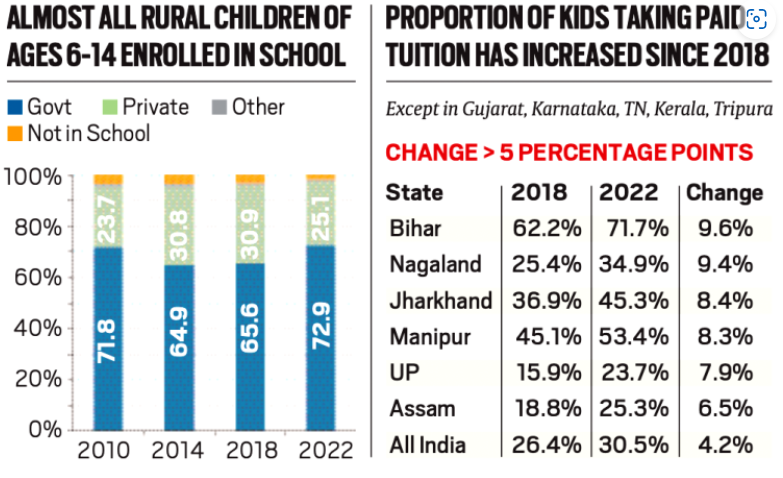
Data on school enrollment of children in rural areas, those taking private tuitions.
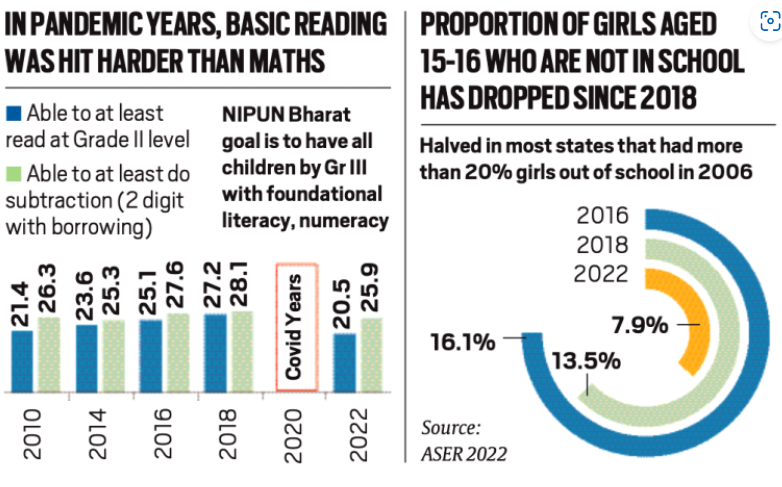
Data on the state of basic reading and maths among students and the proportion of girls (aged 15 to 16 years) who are not in schools.
Impact of Pandemic on Private Tuition and Foundational Skills
Private Tuition
- The reason private tuition went up is probably that it is more flexible.
- Parents felt that schools are closed, we are not sure when they will open, but we need to get some extra help.
- It can be thought of as a local organizing.
- Parents wanting more for their children and going wherever possible to get it.
Foundational Skills
- Emphasized in the National Education Policy of 2020
- 80% of schools have received guidelines and teachers have been trained on schemes like National Initiative for Proficiency in Reading with Understanding and Numeracy (NIPUN) Bharat and Foundational Literacy and Numeracy (FLN) mission.
- Decline in learning levels since 2018, varies across the country.
- Drop in reading is more than in math.
- NIPUN Bharat’s goal is that every child by Class 3 is at grade level.
- Number of such children before Covid was around 30%, and now is somewhere for reading around 20% and for math around 25-26%.
Road Ahead
- Need to take big jumps every year to improve foundational skills.
- Need to shake up things and improve productivity of the country.
- Integration between the anganwadi system and the school system is urgently needed.
- Need to consider catch-up for kids who are past Class 4, 5.
- Consider these points in next year’s plans for states.
-Source: Indian Express
China’s Population Falls
Context:
China’s population, according to its National Bureau of Statistics, fell to 1,411.8 million in 2022, from 1,412.6 million in the previous year.
- India has not conducted an official headcount Census after 2011. But going by the United Nations projections, its population stood at 1,417.2 million in 2022 (more than China’s) and is expected to reach 1,428.6 million in 2023.
Relevance:
GS II: International Relations
Dimensions of the Article:
- China’s population shrinks: Mortality and fertility
- Why China faces a crisis?
- India’s opportunity
China’s population shrinks: Mortality and fertility
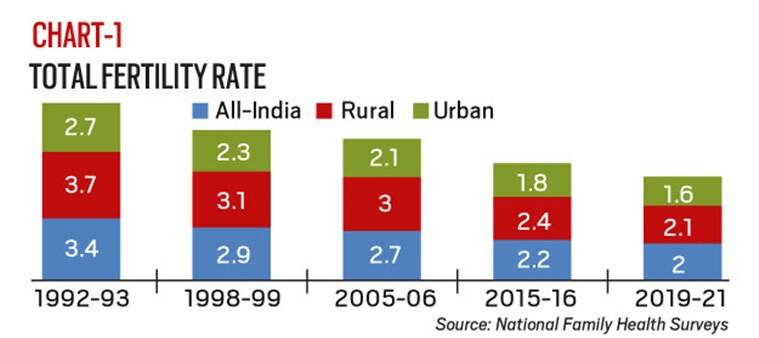
Mortality
- Reduction in mortality leads to population growth
- Mortality falls with increased education levels, public health and vaccination programs, access to food and medical care, and provision of safe drinking water and sanitation facilities.
- Crude death rate (CDR) was 23.2 for China and 22.2 for India in 1950.
- Life expectancy at birth has gone up between 1950 and 2020.
Fertility
- Declining fertility rates lead to population shrinkage
- Total fertility rate (TFR) was as high as 5.8 for China and 5.7 for India in 1950.
- TFR has fallen sharply for India in the past three decades.
- TFR of 2.1 is considered as “replacement-level fertility”
- China’s TFR dipped below replacement first in 1991, which was almost 30 years before India’s
Sustained lows necessary
- Populations can keep growing even with TFRs falling.
- De-growth requires TFRs to remain below replacement levels for extended periods.
- Effects of that may reflect only after a couple of generations.
- China’s population more than doubled from 544 million in 1950 to 1.1 billion in 1987 and peaked in 2021.
- It took over 30 years for below-replacement fertility rates to translate into negative population growth.
Why China faces a crisis?
- China’s TFR, according to its 2020 Census, was 1.3 births per woman — marginally up from the 1.2 in the 2010 and 2000 censuses, but way below the replacement rate of 2.1. China officially ended its one-child policy, introduced in 1980, from 2016.
- But that’s unlikely to stem the decline in the country’s population, which the UN has projected at 1,312.6 billion in 2050, a near 100 million drop from the 2021 peak.
- The real crisis for China, however, is the decline in its population that is of prime working age.
- If there is a large population that’s able to work and earn, not only will there be relatively fewer people to support — those too old or too young — but also greater tax revenues and savings potential from the generation of incomes. As these are directed to finance investments, a virtuous cycle of growth is unleashed — as indeed it happened in China.
- But that cycle has started to reverse, and the share of China’s working-age population is projected to fall below 50% by 2045.
India’s opportunity
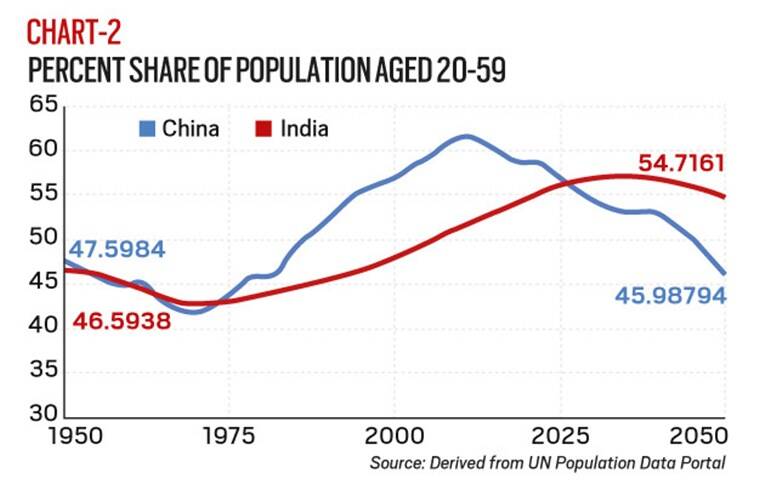
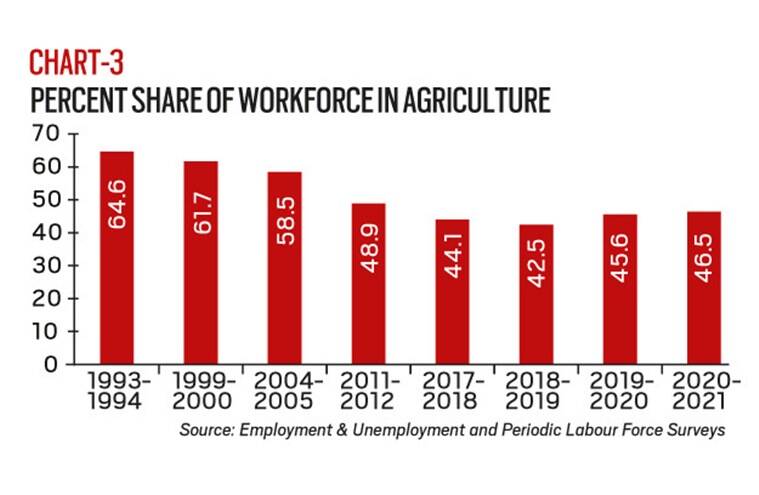
- India’s fertility rates have fallen to replacement levels, including in rural areas due to the spread of education and changes in agricultural practices.
- Despite the decline in fertility rates, India’s population is projected to continue growing for the next 40 years.
- However, India’s working-age population, which crossed 50% in 2007, is set to peak at 57% in the mid-2030s, providing a window of opportunity for reaping a “demographic dividend” similar to China’s in the late 1980s to 2015.
- The success of this demographic dividend is dependent on the creation of meaningful employment opportunities for the young population, otherwise it could turn into a demographic nightmare.
-Source: Indian Express



